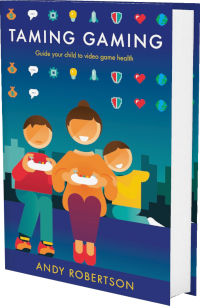 Android
Android iOS
iOS Mac
Mac Switch
Switch Wii
Wii Wii U
Wii U PC
PC PS4
PS4 PS5
PS5 Xbox One
Xbox One Xbox X|S
Xbox X|SWe've documented 25 accessibility features for Home Quest, including Guaranteed Progress, Low Pressure, No Quick Reactions, No Button Combos and No Repeated Pressing. Its accessibility is strongest in Getting Started and Visual but it also has features in Controls, Navigation, Reading and Audio to reduce unintended barriers.
This report is created with input from accessibility experts and the player community to help people find games that have the accessibility features they require. Once you have found potential games on the database, there are excellent specialist accessibility sites that offer in-depth reviews to guide your purchasing decisions.
Our accessibility examiner, Andy Robertson, first checked Home Quest accessibility 2 years ago. It was re-examined by Jan Gressmann and updated 2 years ago.
 Accessibility Notes
Accessibility Notes
The game has some quite small text on smartphone screens. Also the main menus are really low contrast before you have selected one of them which make them harder to see.
Works well with VoiceOver, although there are some quirks to note. As you navigate with VoiceOver, be aware that there are subsections to further explore. For example, when you open up the army, there are sub-sections for Tanks, Damage Troops, Support Troops, and heroes. Different units can be found under each of these headers. However, most of the headers, units, and buildings are locked behind “Question Mark” at the start of the game.
When you gain access to settlements, you can access the new village at the top of the screen. Find the words “Active Village.” Swipe right and you will find a icon. This will lead you to the other available settlements. These sites have alternative resources that can be collected to further your expansion.
Some helpful tips, from Aaron Spelker, to aid progression are:
- It's important to read the Log because it provides you insights into your next goal.
- Keep fighting monsters under the World tab. Eventually, winning these battles will unlock new units, buildings, and settlements.
- Build storage warehouses whenever you can and across all of your settlements. The game can stall if you do not have enough storage space for the materials to build the next building type.
- I recommend entering a battle with at least 50% more troops than the enemy.
- Don’t forget to harvest the material from the Soul Well. The Soul Well is filled by defeating your enemies in battle and collecting their souls.
- When you unlock a better unit, disband the lower unit to make room for the better unit. This is accomplished under the “World” tab by selecting “Send Troops to Valhalla”
Throughout the game, The developer obviously spent time constructing a way to audibly communicate the resource collection and battle progression. Hopefully, The developer will continue to add to the gameplay and lengthen the overall experience.
 Game Details
Game Details
Release Date: 05/09/2021
Out Now: Android and iOS
Players: 1
Genres: Brain Game, Communication (Adventure, Puzzle and Strategy)
Accessibility: 25 features
Components: 2D Side-On and Text
Developer: Code Stream de (@CodeStream_de)
Costs: Purchase cost
 Controls
Controls
We've documented 5 accessibility features for Controls in Home Quest which deal with how you control the game, different options for alternative inputs and whether you can remap these settings to suit your needs.
Touchscreen
Can play with the following. Additional gestures may be required for games played with a screenreader like VoiceOver.
One Tap Targeted: Can play with touchscreen, tap in specific locations.
Button Combinations
Specific button operation required to play
Holding Down Buttons Optional: Holding down buttons for prolonged periods (a second or more) is not required or can be switched to toggling the action on and off. This is in addition to the movement stick/button which is not considered a hold for this purpose.
Rapid Repeated Pressing Optional: Quick, repeated button pressing (more than 2 times a second) is not required, can be skipped or switched to holding a button to trigger a repeated action.
No Simultaneous Buttons: Only one button or key required at a time, in addition to direction stick(s).
Controller Vibration
Vibration Optional: Controller vibration not used in the game or you can disable it.
Similar Games With More Accessibility Features for Controls
If you want to play Home Quest, but it doesn't offer the Controls accessibility features you require, these similar games extend the Controls accessibility:
- Totally Accurate Battle Simulator (11 Controls Features)
- Dicey Dungeons (8 Controls Features)
- Ord (6 Controls Features)
 Difficulty
Difficulty
We haven’t documented any accessibility features for Difficulty in Home Quest which deal with how you can adjust the challenge of play, and whether this is locked once chosen or can be adjusted as you play. The following games are similar to Home Quest, and offer accessibility features for Difficulty:
 Getting Started
Getting Started
We've documented 7 accessibility features for Getting Started in Home Quest which deal with what support is offered to get started with the game. This includes customising the experience when you first open the game via any onboarding processes it provides as well as tutorials and other assistance when you first start playing.
Assistance Getting Starting
These features aid your play of the game in terms of cognitive load on learning controls, dealing with pressure and coping with the environment and challenges.
Tutorials: There are helpful tutorials and instructions on how to play. Information is provided in a timely manner, with appropriate level of detail.
Reaction-Time Not Critical: Individual game actions don’t need quick reactions, or there are settings to lower the requirement for quick reactions. This means you don't need to quickly press a button in response to an on-screen prompt, target a fast-moving target or skillfully complete a scenario against the clock.
Low Pressure: Game tasks aren't time-limited or there's a low-pressure mode. This avoids the pressure of being put on the clock for overarching missions, or failing tasks because you didn't reach a destination in time.
No Jump Scares: No sudden loud noises or popping-up scary visuals that unexpectedly appear without warning, or the option to disable them.
Assistance For Progressing
These features aid your progress through the game offering different ways of maintaining your progression.
Guaranteed Progress With God Mode: There is no fail state for any game level, where you lose progress or have to start again. Or there are options to make failing impossible: infinite health or lives, unlimited time. Sometimes called God Mode or Unfailable.
Assisted Progress With Hints: The game notices if you get stuck (or you can press a button) and provides information to help you progress. This can offer hints or tutorials popping up during play. This includes hints after you have died, where it can suggest strategies or difficulty settings to adjust or offer to skip past problematic levels.
Save Progress Anytime: The game automatically saves progress or you can save any time. This doesn’t mean you never lose progress, but it does mean you can stop whenever you want (without having to get to a save point) without losing progress.
 Reading
Reading
We've documented 2 accessibility features for Reading in Home Quest which deal with how much reading or listening comprehension is required, how well the game provides visual and audible access to the text and whether subtitles and captions are a good fit for purpose.
Reading Level
How much reading is required to play the game's main path or story and how complex the language is. The presence of voiced characters doesn't reduce this requirement, as it's recorded as a separate datapoint.
Moderate Reading: Moderate reading required. The quantity and complexity of reading are at a level that a high school student (14-year-old) would appreciate.
Subtitles
All Speech Subtitled (Or No Speech In Game): All spoken content has subtitles, or there is no speech in the game. This means there is no requirement to hear spoken dialogue or narrative to play the game.
Similar Games With More Accessibility Features for Reading
If you want to play Home Quest, but it doesn't offer the Reading accessibility features you require, these similar games extend the Reading accessibility:
- Wargroove (6 Reading Features)
- A Dark Room (6 Reading Features)
- Todo Math (4 Reading Features)
- Storyteller (4 Reading Features)
 Navigation
Navigation
We've documented 3 accessibility features for Navigation in Home Quest which deal with how the game provides guidance and assistance to navigate its worlds. These are only for games that have traversal and exploration in 2D and 3D spaces.
Clarity
Clear Mission Objectives: The game provides clear, structured missions with directional guidance and advice on which can be attempted next. This also indicates (ideally on maps where they are provided) which missions can't be attempted because you do not have the appropriate items yet.
Head-Up Display
Game Map: View a map of the game world during play, with the landscape, points of interest and missions highlighted throughout the entire game. This enables the orientation of the player and the world, confirming a direction of movement and the location of destinations or points of exploration.
Menu Navigation
Menus Don't Wrap: Menus don't wrap and stop the cursor at the bottom of the list if you press down. Or menus do wrap but make it clear that you are back at the top of the list with sound or narration.
 Visual
Visual
We've documented 7 accessibility features for Visual in Home Quest which deal with how you can adjust the visuals to suit your needs, and offer additional information if you can't hear the game.
Contrast
Medium Contrast: Game uses generally well contrasting and bright visuals, or has a slider to make this the case.
Visual Distractions
No Flashes: No flashing strobe effects or you can disable them. This includes the absence of flashing from dramatic visual effects, explosions or weather effects like lightning.
No Screen Shake: No screen shake effect or it is included but it can be disabled. This includes the absence of screen shake for dramatic effect as well as to indicate hits on a target.
No Busy Backgrounds: No distracting backgrounds or you can make them static or blank. This includes the absence of other movement elements in the background that might distract or confuse the action. Where foreground contrast is high, this includes games with some movement in the background that doesn't make it overly difficult to distinguish what is happening.
Motion Sickness Friendly
Motion Sickness Friendly: Doesn't have 3D movement elements that may trigger motion sickness, like motion blur, depth of field and field-of-vision. Or includes the ability to disable motion blur, depth of field and field-of-vision effects.
Colour Options
Colour Blind Friendly: Game doesn’t rely on colour or can switch to colour blind friendly mode with double coding or similar way to avoid colour dependance.
Play Without Sight
Play Without Sight on iOS with VoiceOver: The game can be played without sight by fully supporting the built-in VoiceOver screen reader on iOS. This includes clear text on buttons and intuitive navigation so VoiceOver can be used to read all interactive elements.
Similar Games With More Accessibility Features for Visual
If you want to play Home Quest, but it doesn't offer the Visual accessibility features you require, these similar games extend the Visual accessibility:
- Universal Paperclips (8 Visual Features)
- Ord (8 Visual Features)
 Audio
Audio
We've documented 1 accessibility feature for Audio in Home Quest which deals with how you can adjust the audio of the game and whether audio cues compensate for aspects of the game that are hard to see.
Play Without Hearing
Play Without Hearing: No audio cues are necessary to play the game well.
Similar Games With More Accessibility Features for Audio
If you want to play Home Quest, but it doesn't offer the Audio accessibility features you require, these similar games extend the Audio accessibility:
- King Pins (3 Audio Features)
- Todo Math (2 Audio Features)
- Ord (2 Audio Features)
- Totally Accurate Battle Simulator (2 Audio Features)
System Accessibility Settings
In addition to the accessibility features provided in the game, you can also use system-wide accessibility settings:
Android
Android has accessibility settings including ways to navigate and interact, although not all games support this.
iOS
iOS has a very extensive suite of accessibility settings including ways to navigate with voice and comprehensive screen reading, though most of the features don't work with games.
Read more about system accessibility settings.
Accessibility Report supported by VSC Rating Board, PlayabilityInitiative and accessibility contributors @TripleTapTech, Andy Robertson and @codestream_de












